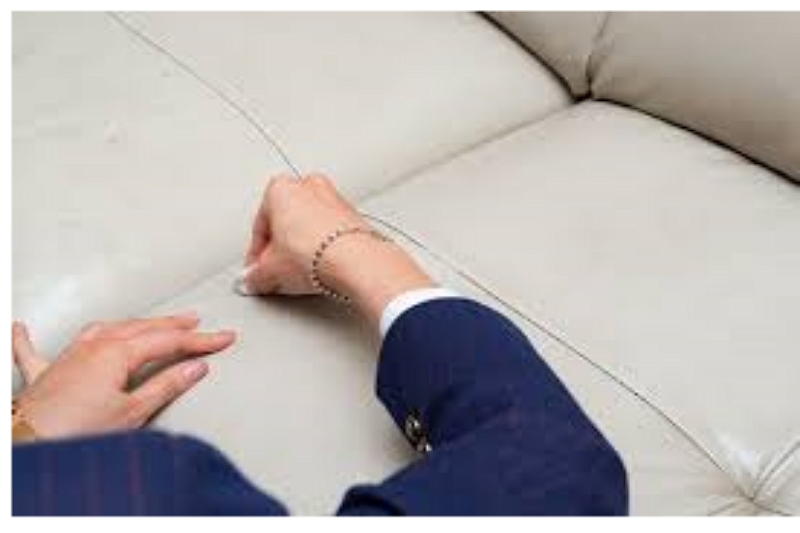Nail glue is very strong and can be difficult to remove. Thankfully, there are some easy ways to remove it from your recliner.
In this blog post, we will discuss how you can use acetone, nail polish remover, or soap and water to clean up the acrylic nail glue on recliner.

Steps on How to Clean Acrylic Nail Glue on a Recliner:
Step 1. Apply acetone or nail polish remover to the recliner and allow it to sit for a few minutes.
Step 2. Pour soap on top of acrylic glue and scrub gently with a cloth until all residue is gone. Rinse off excess soap, dry the area thoroughly before sitting back in your chair again!
Step 3. Use hot water and dish detergent to clean the recliner. Let dry before you try sitting in it again
Step 4. Use a hairdryer and a mixture of soap and water over the top layer, then use your fingers or nail brush to scrub off acrylic glue residue from any stubborn areas on your chair.
What is Acrylic Nail Glue on a Recliner?
Acrylic nail glue is a liquid that’s used to attach false nails, tips, or wraps for your fingers and toes. It typically comes in clear bottles and is applied directly on the fingernails or toenails with an applicator brush before being dried under UV lights.
Acrylic can last anywhere from two weeks up to six months depending on how often you wear your nails.
How to Prevent Acrylic Nail Glue Stain on a Recliner?
#1. Wash the recliner with a mixture of soap and water.
#2. Use a hairdryer to dry as much acrylic glue residue off as possible before you try sitting in it again. You can also use your fingers or nail brush to scrub off more stubborn areas that are difficult to remove with just water alone.
#3. Vacuum the area where you removed the acrylic nail glue.
#4. If your recliner is still sticky after washing, try using a furniture polish to create an invisible barrier that will keep any new residue from sticking to the fabric in the future and make it easier for you to clean up those areas as needed later on.
#5. You can also use some newspaper or aluminum foil to prevent the glue from sticking in the first place.
#6. If acrylic nail glue sticks to your clothing, you can put it in a plastic bag with some water and wash as usual.
#7. Allow time for drying before sitting on or using any of these items again so that there is no chance of transferring more residue onto them.
How to Deep Clean a Recliner with Stains
Your recliner should be cleaned every month to keep it fresh and clean for your family. It is important that you deep-clean the recliner at least once per year, depending on how often it is used by the whole family. To do this, use soap and water or an upholstery cleaner diluted in warm water (for upholstery).
Step 1. First, vacuum the recliner to remove any loose dirt and debris. Upholstery cleaner, soap, or water should be used for cleaning.
Step 2. Next, use either a soft brush or sponge on seats and cushions that are made from fabric (or vinyl with a strong backing) but avoid using them on more expensive leather and fabric chairs that are susceptible to water damage.
Step 3. Finally, before you begin scrubbing the furniture with a rag or sponge, use distilled white vinegar for stains on upholstery or spills from drinks like coffee, tea, or juices if they have dried.
The acid in this type of cleaner will cut through these types of stains, so be sure to give it a few minutes before taking action.
Step 4. If the furniture is made from fabric or vinyl with a strong backing, use soap and water on seats and cushions that are not waterproof.
How to attach a Recliner Slipcover
Step 1. The first thing you will want to do is choose the best side for your slipcover.
You mustn’t have any metal or sharp objects on this site, because they might puncture through the fabric and cause permanent damage. You should also avoid attaching it too tightly because it could tear the fabric.
Step 2. Once you have chosen your side, take one of the closed-end straps and put it on either side of the backstrap in the front panels.
Do not be too close to an edge or seam as this will cause wrinkles when you pull tightly through them later. Now find another open-end strap in any other panel and pull it through the back of both straps.
Step 3. Now take a strap in your hand from one side panel, stretch to an end panel on the other side and get as close to the edge or seam without creating any wrinkles, then grab hold of another strap at the same time near this edge or seam.
Pull tightly together until you reach the next edge or seam.
Step 4. Repeat the process until you reach one end of the back panels, then tie off with a secure knot and cut away any excess strap that is not needed anymore.
Step 5. The other side should be done in the same way, so carefully take all straps from closed to open as they were before, and pull until you reach the other end.
Step 6. Now take a strap in your hand from one side panel, stretch to an end panel on the other side and get as close to the edge or seam without creating any gaps.
Step 7. Tighten the strap by pulling on it, and then continue to tighten all straps before working your way back to the other side panel.
